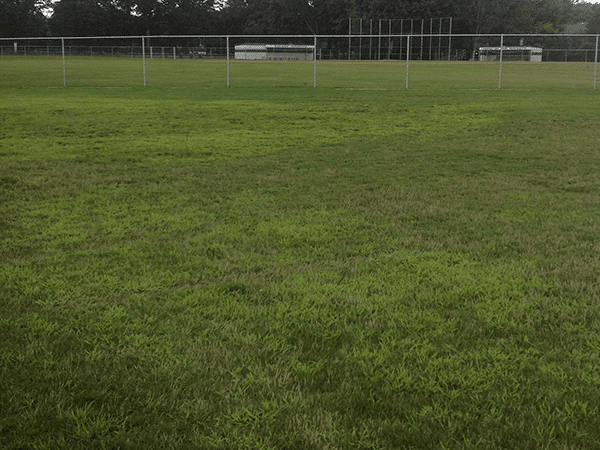Dithiopyr Vs Prodiamine

Every year, I am always asked which product is better to use as a pre-emergent for crabgrass in the spring, and my answer is always, “Well, it depends.” There are several options, but it usually comes down to two: Dithiopyr, aka Dimension, and Prodiamine. Both are great products depending on when and how they are used, so, let’s talk about them a little more in-depth.
First, let’s talk about what these products specifically do. Pre-emergents don’t actually stop the seed from germinating. As the seed germinates, the baby seedling comes in contact with the pre-emergent chemical layer in the soil and absorbs it. The chemical stops cell division in the plant, either root or shoot, preventing it from reaching the soil surface and sunlight. As a result, it dies. This is why they are called pre-emergents. They kill the seedling prior to emerging from the soil, but they don’t kill the seed. Over time, pre-emergents are broken down by microbes and environmental factors and, therefore, must be reapplied annually. Sometimes, it must be even applied semi-annually to extend control.
Years ago, the first pre-emergent applied to granular fertilizer was Pendimethalin or Pre-M. This product was a huge victory for lawncare because it opened the door for many other granular combination products to be created. This made it possible for many new businesses to offer lawn fertilization because they no longer needed liquid application equipment to get the job done. Yet, we all know about the issues with pendimethalin. Many of my customers still have yellow floors, pavement, equipment, and toilet seats from pendimethalin. It stains!
Dimension was brought on the scene by Dow (now, Corteva). The new chemistry was applied to fertilizer, increased the length of control from weeks to months, and, the best part of all, it didn’t stain. It worked a little bit differently than Pre-M, but accomplished the same goal. The non-staining issue alone meant love at first sight for the applicator.
Prodiamine is actually one of the more recent chemistries for preventing crabgrass. It works much like Pre-M, and has a yellow color, but has much less of a staining effect and a much longer residual. Even though it has come on the scene more recently, it has, in my opinion, become the dominant pre-emergent product used today. Prodiamine has performed better and is more cost-effective than Dimension south of the Mason-Dixon. Also, there are many post-patent alternatives now available, which has brought the cost of this chemistry down significantly.
So which one is better? Since I sell and monitor the performance of both, I think I can help. If you plan on going out with pre-emergent first thing in the spring, I recommend Prodiamine because it does not leach with heavy rainfall the way Dimension does. We can have some pretty wet springs in the Cleveland area and, in those instances where March pre-emergent applications were made, Prodiamine outperformed Dimension.
Some of my customers opt to apply pre-emergent later in the spring, closer to the crabgrass germination window, or they have late sign-ups that they still want to treat. In those cases, there is less risk of pre-emergent leaching and, in this situation, Dimension may be a better choice. Dimension is more soluble, so it will set up in the soil faster than prodiamine. It also has some early post-emergent control if you are lucky enough to hit crabgrass at the right time. In some cases, I have my customers mixing Dimension 2EW in with their weed control, since they are usually total spraying properties at that time anyway. I have always felt that the time frame in which my customers start spraying broadleaf weed control is the perfect time to start applying Dimension.
So timing and weather aside, some of my customers have a strong preference for one product over another, and that is fine as long as you compensate for the products with either proper timing or appropriate rates. I typically recommend a rate in my territory that applies 0.65Lb – 0.73Lb active ingredient/acre of Prodiamine, or 0.25Lb – 0.38 Lb active ingredient/acre of Dimension. You should always refer to the label and talk with your local ATS representative first because each region is different. The research I have read suggests that there is no benefit from split applications of Prodiamine, so if you are a one-and-done kind of person, either product can be applied as long as you apply the right amount of either product.
If you are a Dimension lover, you can split the rate over two applications in the spring, or apply your first application as a granular and follow-up with a liquid app mixed with the weed control mid-late spring. Some have even gone with a full rate of Dimension on the first round and reinforced with more on a second round. Personally, I feel that the cost of applying more outweighs the benefit because breakthrough can result from many factors. You are better off, in my opinion, to budget for the cost to treat a percentage of break-through each year on your total acreage in your pricing structure, say 3%, as an insurance policy to use when you need it.
Speaking of breakthrough, there are many things that can cause it. If conditions are too dry to disperse the chemistry into the soil, if the ground cracks, if the turf isn’t mowed at the proper height, or if it is too wet in a certain year; all of these things can affect performance and are out of your control. Unfortunately, the customer is not usually as understanding, so make sure that your agronomic program is flexible. My customers do second pre-emergent applications to compensate for problem properties or adverse conditions and it may be advisable for you, also. So, keep an open mind and be willing to make changes to your program when necessary and you and your customers should be trouble-free.
Sam Weil,
ATS Sales Representative







